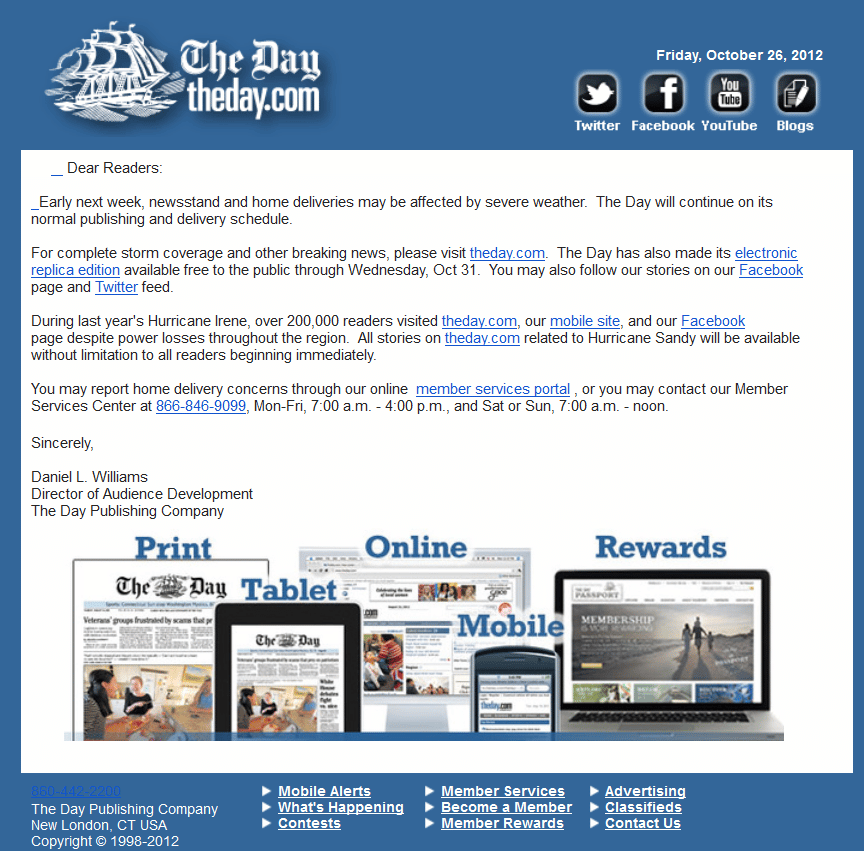This week, a number of news sites, including The New York Times, the Wall Street Journal, the Baltimore Sun, and Newsday, dropped their paywalls in response to Hurricane Sandy, which seemed like a highly ethical move. After all, journalism is meant to inform the public, and it’s a bit unseemly to keep news about impending destruction behind a paywall.But this may not just be an ethical/PR move. After releasing its Q3 financial reports, it looks like The New York Times is experiencing a dip in advertising revenue. By knocking down its paywall for a few days, the site is sure to may see a surge in visitors, thereby increasing its digital advertising revenue in a short time with little effort. Sure ,it’s not a long-term growth strategy, but it’s not a bad way to boost profits for Q4. (Update: Apparently, spikes in site traffic don’t bring the advertising dollars I presume they do here. See below for a comment from WSJ Managing Editor Raju Narisetti.)Local papers, on the other hand, have had varied responses. Some followed the national papers’ lead, including the Pocono Record, the Cape Cod Times and SeacoastOnline.com (all owned by the Dow Jones Local Media Group), and surely local sites will see increased activity during the storm (so long as the power doesn’t go out). If these sites are supported by digital advertising, then this is both a smart PR move and business tactic.But of all the local papers, The Day had the most interesting tactic, using its online content and digital replica as a back-up for print subscribers. The paper issued this email this morning:

In case you can’t read that fine print, here’s the body copy:
Dear Readers:Early next week, newsstand and home deliveries may be affected by severe weather. The Day will continue on its normal publishing and delivery schedule.For complete storm coverage and other breaking news, please visit theday.com. The Day has also made its electronic replica edition available free to the public through Wednesday, Oct 31. You may also follow our stories on our Facebook page and Twitter feed.During last year’s Hurricane Irene, over 200,000 readers visited theday.com, our mobile site, and our Facebook page despite power losses throughout the region. All stories on theday.com related to Hurricane Sandy will be available without limitation to all readers beginning immediately.You may report home delivery concerns through our online member services portal , or you may contact our Member Services Center at 866-846-9099, Mon-Fri, 7:00 a.m. – 4:00 p.m., and Sat or Sun, 7:00 a.m. – noon.Sincerely,Daniel L. WilliamsDirector of Audience DevelopmentThe Day Publishing Company
This is a great way to show subscribers why digital access is needed and valued for local news. It’s also a savvy customer service move — averting customer discontent before it even happens.This is in contrast to The Boston Globe, which choose to tweet that storm coverage would be available for free on its sister site, Boston.com. This decision neither highlights The Globe’s digital offerings, nor does it keep Boston.com/Globe readers informed in a helpful way — it would have been better for The Globe to email registered users directly, instead of relying on fleeting tweets and social media updates.So overall, it helps local and national papers to take-down their paywalls on a temporary basis, so long as they 1) have the digital advertising to support free viewing, and 2) have the common sense to use customer service best practices to alert readers to what they’re offering.For more great ideas for monetizing local news content online, check out our in-depth Case Study on The Day at Subscription Site Insider.UPDATE: I shared this post with WSJ’s Managing Editor Raju Narisetti on LinkedIn and got schooled by his reply:
Minal–some really faulty assumptions here. I can’t speak for the New York Times decision but here is my reasoning at WSJ: we are unlikely to easily deliver print papers to all our subs up and down the east coast so opening up wsj.com is good, proactive customer service in addition to good public service for digital readers in what will be a very dangerous period. Of course more audience means more ad impressions but you are mistaken in thinking big sites have the ability to monetize random audience spikes beyond normal monetization. While these decisions have to be joint news and business decisions, you might be pleasantly surprised to know we aren’t all as cynical as critics make us out.
Map of Hurricane Sandy’s path is courtesy of Google Crisis Response .







